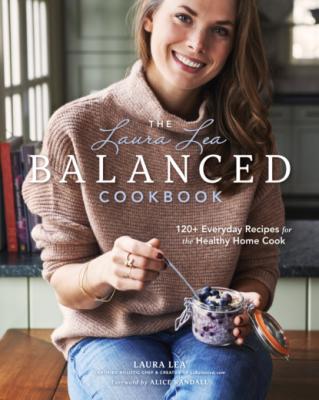The Laura Lea Balanced Cookbook. Laura Lea
Читать онлайн.| Название | The Laura Lea Balanced Cookbook |
|---|---|
| Автор произведения | Laura Lea |
| Жанр | Кулинария |
| Серия | Laura Lea Balanced |
| Издательство | Кулинария |
| Год выпуска | 0 |
| isbn | 9781951217112 |
Cast-iron skillets. A different animal
altogether, these classic heavy pans are
a great investment. They don’t cost a lot
and they get better with age, if properly
taken care of. Cast-iron takes a little
while to get hot, but it gets screaming
hot and has excellent heat retention. I
use my cast-iron skillet when I want to
make sure that the dish is cooked evenly
through, such as my Pesto Chicken &
Spinach Frittata (page 137) or Summer Peach & Blueberry Crumble with Coconut Cashew Cream (page 323). I also use it for nonstick cooking, like with my Customizable Oat Johnnycakes with 20-Minute Chia Berry Jam (page 118). “Seasoning” your cast-iron skillet protects it from heat and makes it durable.
To season cast-iron: Preheat oven to
325° F. Wipe down skillet with a wet cloth
and dry thoroughly. Apply a thin coat of
any oil of choice to the skillet (I use olive
oil). Place skillet upside down on center
oven rack, and place a sheet of aluminum
foil on bottom rack to catch dripping oil.
Bake for an hour, turn off oven heat, and
allow skillet to remain until completely
cooled. You’ll know you need to re-
season your skillet when it is no longer
smooth and shiny.
To clean your cast-iron skillet. Do not
wash with soap or scrub with a metal
brush or sponge; this will damage it.
Wash under hot water with a textured
sponge as soon as possible after cooking.
If this doesn’t clean it completely, add a
few tablespoons of sea salt and scrub the
salt into the skillet with a paper towel or
dish rag. Rinse thoroughly.
Green nonstick pan. Traditional nonstick
pans/skillets have been shown to release
toxic gases at high temperatures, making
them an unsafe option. However, some
companies are now making “green”
nonstick ceramic skillets that purport to
eliminate health concerns. I have one grill
pan from a company called GreenPan,
and I’ve used it successfully. If you would
prefer not to invest in a cast-iron skillet,
you can look into “green” or “eco” pans
to determine how you feel about them.
• Immersion blender
• Ice cream maker
• Wire cooling rack (can use a slotted baking
sheet instead)
STORAGE EQUIPMENT
• Variety of glass sealable containers
(I like Glasslock)
• Food storage zip-top bags: Perfect for frozen
fruit and dry goods such as flours, nuts,
and grains.
• Insulated food and beverage containers:
I like Thermos brand. These are useful for
food-to-go and in lunch boxes, for both
hot and cold items. An optional item is a
Yeti cup (or one from a similar, knock-off
brand), which keeps liquids hot or cold for a
long time.
• Mason jars: Great for soups, smoothies, and
salad dressings.
Pantry Food Staples
The following are MY staples and the staples
for this book. If you buy and stock these, all
you will have to do is purchase perishable items
when you want to make a recipe: fruits, veggies,
meat, eggs, dairy. Start here and feel free to
experiment with ingredients as your comfort
with cooking grows. Note I have tagged some
ingredients with an *. These are ingredients
that are a bit more exotic—I have included
suggestions for using them starting on page 42.
Swapping
healthy fats
into your diet
is as simple as
using grass-fed
butter, organic
coconut oil, and
olive oil, and
leaving behind
hydrogenated
and trans fats.
FATS
• Extra-virgin olive oil: As classic as it gets;
I probably use olive oil every single day in
cooking. Its slightly savory umami flavor
pairs with almost any protein or vegetable,
and it is full of heart-healthy fats. When
it comes to olive oil, make sure you are
purchasing “extra-virgin first cold-pressed”
oil, and look for a bottle that is dark/opaque
(to protect it from destabilizing sunlight
heat). This ensures you are getting the
freshest, highest quality olive oil, which
easily goes rancid.
• Extra-virgin organic coconut oil*
• Grass-fed butter: What is left to be said
about butter? It makes everything taste
better, richer, more satisfying, and more
complex. I use it in moderation, as I do
all ingredients, but there are certain
instances in which nothing beats butter—
like slathered on a freshly baked muffin
or tossed in pasta with a pinch of sea salt.
I always have Kerrygold grass-fed butter
in my fridge, and unless you have a dairy
allergy or intolerance, I recommend the
